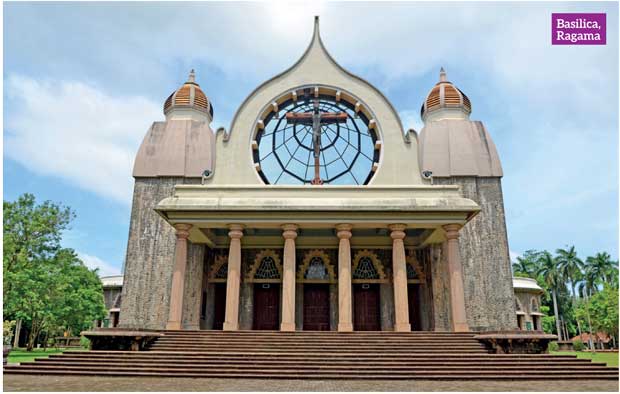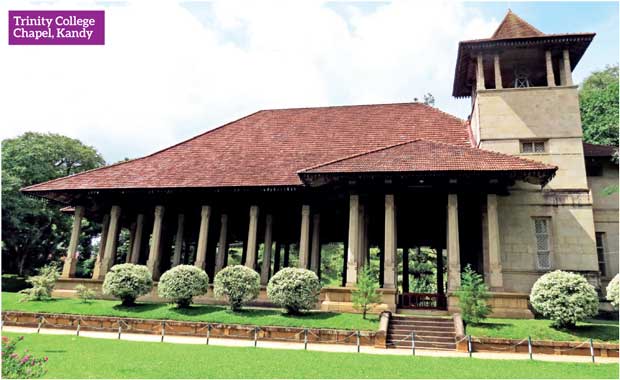Reply To:
Name - Reply Comment

 The decolonisation of church architecture in Sri Lanka needs to be understood within the context of nationalist movements that emerged in the late 19th century. It is noted that the reformist movements, particularly the Buddhist revivalists, radically influenced the process of indigenisation of the colonial church. For instance, there have been some genuine efforts, especially on the part of the Anglican Church, to become an indigenous faith as early as the 1930s when the word ‘Anglican’ was dropped and it began to call itself as ‘The Church of Ceylon’ as an autonomous local church.
The decolonisation of church architecture in Sri Lanka needs to be understood within the context of nationalist movements that emerged in the late 19th century. It is noted that the reformist movements, particularly the Buddhist revivalists, radically influenced the process of indigenisation of the colonial church. For instance, there have been some genuine efforts, especially on the part of the Anglican Church, to become an indigenous faith as early as the 1930s when the word ‘Anglican’ was dropped and it began to call itself as ‘The Church of Ceylon’ as an autonomous local church.
According to Anoma Peiris, since the architectural dimension of colonial period church buildings had been neoclassical in style with no pretensions of a context or identity of the country, the rising challenge of Buddhism during the early years of anti–colonial nationalism produced an exemplary shift towards an indigenised expression in church architecture. The pressure against Christianity led to the adaptation of Buddhist architectural forms for both Protestant and Catholic churches. On the other hand, the pressure of criticism against the Christians in Sri Lanka had increased with the growing strength of the nationalist discourse and an effort needed to be made in support of their endeavour. As a result, the influence of nationalism came in the 1930s in the form of religious architecture. The very first structures that chose to make this statement were the chapels of Teacher Training College (1920) in Peradeniya and Trinity College (1935) in Kandy.

The specific form that inspired for the Trinity College Chapel was a colonnaded hall that existed in several examples of traditional architecture of historic eras. The forest of fifty stone pillars standing on a high stone podium closely resembled the king’s Audience Hall in Kandy. In doing so, it created a building that was far closer to the pre-colonial cultural experience of the society. The entire wall behind the altar is transformed by a life-size mural of the crucifixion. The theme of the murals, though biblical in inspiration, was always represented in a localised context with local people as its models which further indigenised the interior. Anoma Peiris writes whereas previously stained-glass windows had been imported from Europe, from this period onwards, local artists began to paint scenes based on indigenous themes inside churches. They used local fisherfolk or indigenous plants and landscapes for their inspiration. Moreover, the use of local material such as timber and brass, particularly for the tabernacle, and the application of motifs typically found in Buddhist temples, further indigenised the churches.
The sway of post-political independence
The initiatives taken by the ‘Christian nationalists’ with the authority of priests greatly influenced the church architecture of the island. It can be noticed that during this period, ‘indigenisation of colonial expression’ had become a necessity; many of the new churches deliberately adopted the forms of Buddhist and Hindu aesthetics. As Shanthikumar Hettiarachchi points out, these attempts to become indigenous ecclesial communities rather than churches planted in the manner and style of their ‘mother church’ in Europe or elsewhere, developed a praxis that led to relations with other national movements. Once again, the Anglican Church led the process of indigenisation as an ecclesial priority in several projects. The continuation of preceding architectural experiments of the Anglicans were demonstrated in their cathedrals of ‘Christ the King’ (1960) in Kurunegala and ‘Christ the Living Saviour’ (1973) in Colombo.
Most of the architectural details of the Cathedral of Christ the King, Kurunegala have been inspired by the traditional architecture of the Anuradhapura, Polonnaruwa and Kandyan periods. The main feature of the superstructure of the building is the Buddhist Octagon. Another noteworthy detail is the arches found in the building as in the Lankathilaka Temple. Following the Hindu concept of Vimana, the altar of the cathedral is placed within the highest part of the building. The roof of this sacred area has been constructed as an octagon structure to resemble the form of ‘Paththirippuwa’ of the Temple of Tooth Relic in Kandy.
The apex of architectural experiments of this movement is seen in the Cathedral of Christ the Living Saviour in Colombo. Although the architectural form of the cathedral is reminiscent of a Buddhist temple, it goes a step further and attempts to give a contemporary statement of Christian sacred space and a rationale for the process of indigenisation within the context of architecture. An effort has been made to make the building an open place. The slope of the floor downwards towards the sanctuary suggests the glory of God who came down to earth to dwell among the people. Therefore, the bishop, priests and people are all seated at the same level. The communion table has been placed in a central position to receive a great prominence in the building, suggesting the incarnation of Jesus Christ in the midst of the people. The entire building looks unfinished. It is by design in order to constantly remind the faithful of the unfinished task accomplishing the journey of the mission.
The renewal of Second Vatican Council
The decolonisation of church architecture in Sri Lanka also coincided with the rejuvenation of the Second Vatican Council in the 1970s, and created more opportunities to the Catholic Church to extend and continue architectural experiments like their counterparts in the immediate pre-Vatican period. The council recommends that the Church should everywhere become a ‘native Church’ integrated into the national cultures and it also advocates a wholesome feeling for the country, while it warns of excessive nationalism. In terms of re-modelling and re-furnishing of church interiors, from this period onwards traditional arts and crafts like colourful Lacquer and Batik work have adorned the wooden facets on crosses, communion rails and candlesticks.
The Votive Basilica of Our Lady of Lanka (1974) in Ragama can be seen as a precedent for the architectural programme which was sandwiched between the post-colonial Sri Lanka and the world of Vatican II. In that sense, the dedication of the Basilica is significant; it was consecrated under the title of ‘Our Lady of Lanka.’ Na flower (Mesua ferrea), another national symbol of Sri Lanka, was incorporated to the statue of Our Lady of Lanka. From an architectural perspective, it was intended to meet the requirements of combining ecclesiastical tradition with oriental architecture. However, the original plan tended to be more weighted on the side of Indian traditions, particularly the ‘Chaitya Salawa’ model.
As an ending note, the decolonisation process of church architecture in Sri Lanka must be viewed as a history of a marginal tradition with colonial origins and relations. It can be perceived that these cross-cultural architectural adaptations occurred without much awareness and reflection on these Hindu-Buddhist symbolisms. Post-colonial critics like Shanthikumar Hettiarachchi reasons Christian thinkers and leaders of that period – had no pre-colonial perception of the self-understanding of Christianity, except to accept a colonial construction of Christian expression. It is for this reason that a process of indigenisation was imperative as the churches lacked a pre-colonial body of knowledge and a possibility of an indigenous Christianity, as in the case of Indian experience of an indigenised Christianity of the St. Thomas tradition. It is regretted that during this period, local churches in Sri Lanka had lost the opportunity to experiment with a local style of Christian architectural tradition, more importantly to situate the Christian understanding of sacred time and space within the context of building techniques which have been evolved to suit local environmental conditions.